Q&A – Ask Neil: July 25, 2024
(Please read these instructions carefully.)
Before you post your question, please look at recent issues to see if someone else has already asked it. You might find your answer there.
How to submit your question…
(Note: You may need to allow a pop-up window to come up in order to get the link for sending your photo(s). If you have already submitted your question and didn’t see the pop-up window, please click here.)
• Click the link provided below to post your question. After you submit your question, a new window will pop up giving you the address to which you can e-mail a SHARP, HIGH-RESOLUTION PHOTO to accompany your question. Please DO NOT SEND THUMBNAIL PHOTOS in case I need to zoom in to see things.
• Click here to post your question.
• Please ONLY POST YOUR QUESTION ONE TIME. We can only accept a set number of questions each week, and when we get duplicates it costs other people their chances.
• One question per reader, please.
• Please use this only for posting questions – not for standard emails.
• Watch for your answer in the following week’s e-gardens.
• I choose those of greatest general interest. For example, plant IDs seldom make the cut.
• I must have your first name or initials.
• I must have your city or county. (Texas is a very large state.)
QUESTION 1
WHY ARE MY CRAPE MYRTLE BRANCHES DYING?
Question: I’ve looked through all your crape myrtle archives and I can’t figure out why half of my crape myrtle branches are dying. Samantha W., Grand Prairie.
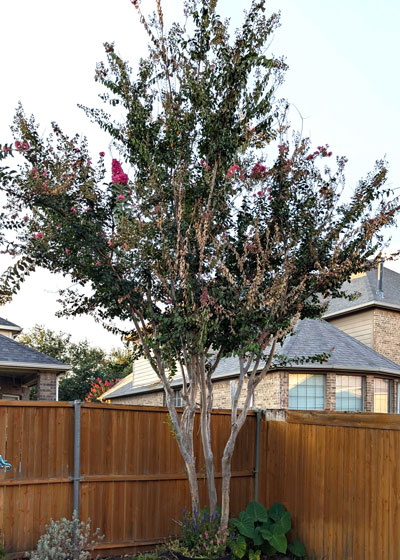
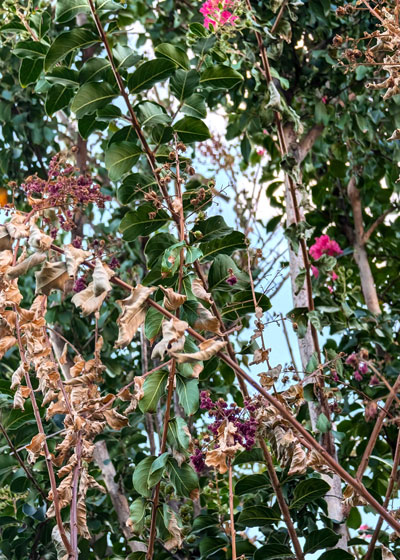
Answer: I agree with you – this is a bit out of the ordinary. Based on 25 years of working with many thousands of crape myrtles in our Crape Myrtle Trails of McKinney, I’m suspecting you have the variety Tuscarora. It’s one of the really pretty rose-red selections from the breeding program of the U.S. National Arboretum from the 60s, 70s and 80s. It was one of the first batch that we planted in McKinney in 1999. Unfortunately, we have found it also to be one of the least winter-hardy varieties in North Central Texas. Tuscarora has frozen to the ground a couple of times for us. We also have many plants in our plantings that look like your plant looks – with a few dead branches sprinkled in among the otherwise healthy growth. Part of this is still due to the cold of February 2021, and part is due to the past two winters that have each had their own issues. I looked very closely and I see no evidence of aphids or bark scale, so good job in keeping them away.
I would suggest watching it the balance of this year. If it continues to die back, consider cutting the entire plant back to the ground – all stems – and letting it regrow from its roots next spring. It will amaze you at how quickly it will come back and fill in.
QUESTION 2
WHAT IS A GOOD ALTERNATIVE TO ENCORE AZALEAS?
Question: What would you recommend in place of Encore azaleas here? As much as I love them, I just can’t get them to flourish. Lou G., McKinney.
Answer: That’s a tough assignment because nothing else really looks or blooms like an azalea. I’m a huge fan of dwarf hollies. Types that would be about that same size would include dwarf yaupon, dwarf Chinese, dwarf Burford, and Carissa hollies. Compacta nandina is also excellent, and many people like the dwarf abelias and low junipers. If it were my choice, however, I’d use hollies and nandinas for much of the framework of my landscape, and in a spot that receives morning sun and afternoon shade, I’d carve out a bed where I could create a 20-inch-deep bed of peat and pine bark mulch for the azaleas. I’d confine my azalea plantings to 5 to 7 plants in morning sun, afternoon shade, and I’d plan on changing them out every 8 or 10 years. Limit your risks and you should find them less frustrating.
QUESTION 3
WHAT CAN I DO WITH MY SILVER MAPLE’S TRUNK?
Question: My silver maple has been wrapped since it was planted approximately three years ago. This weekend I rewrapped it, and I noticed that it still seems to have sunscald damage. What can I do? Matthew M., Heath, Rockwall County.
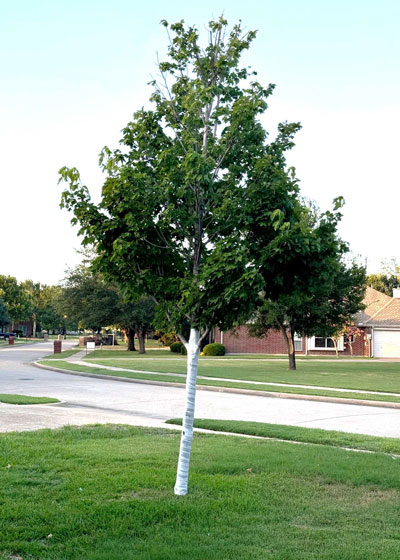
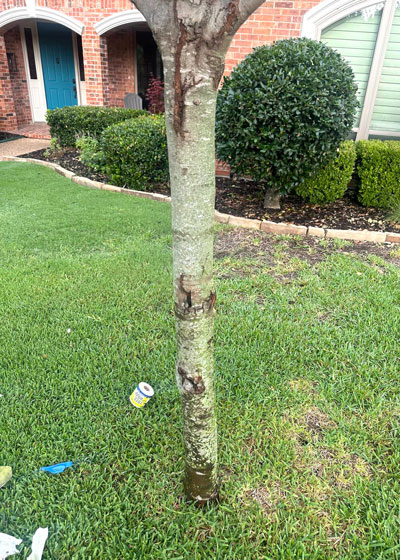
Answer: My guess would be that there was the beginning of sunscald before you got the tree planted. It might have happened in the nursery. But the fact remains that there is serious decay underway. You can see its effects in the loss of small branches at the top of the tree. That would suggest internal decay up the central core of the tree.
I don’t want to come across as a mean-spirited guy, so I hope we remain friends after I make a few comments and suggestions.
This tree appears to be planted too deeply. Notice how you can’t see the root flare at all. The trunk goes straight into the ground without any indication of where the uppermost roots might be. I would normally suggest exposing the root flare with an air spade or by careful digging, but I see other problems.
The tree isn’t plumb. I very carefully tilted and cropped your photo in Photoshop so that all of the corners of the houses, mailboxes, etc. would be perfectly vertical. The tree does not match them. That will always be the case, even if it were to survive and grow to be a large tree – it will always have the lean unless you dig and replant it.
It’s a silver maple. Of all the species of maples, that’s one of the less desirable types. It will not add much to the value of your home if it were to live to maturity. It has a short life expectancy – 25 or 30 years, perhaps less in the Blackland soil where you live. It’s normally fast-growing, but it’s susceptible to borers, cotton root rot, and several other serious problems. Silver maples typically start dropping leaves in mid-summer and keep dropping leaves until the first frost. In that respect, they’re messy trees.
Those factors, combined with the issues that brought us to this conversation, along with the lovely neighborhood in which you live and the attractiveness of your home, lead me to suggest that you consider replacing this tree with another type of tree of higher quality. Some I would consider for your area and for this setting would include Shumard red oak, Chinquapin oak, bur oak, cedar elm, and Chinese pistachio.
I hope that’s all helpful, and I hope we’re still friends after all my comments.
QUESTION 4
WHAT CAN I DO WITH A GARDEN FILLED WITH ROOT KNOT NEMATODES?
Question: My vegetable garden has a horrible case of root knot nematodes. It produced no zucchini or patty pan squash, and the bean plants were afflicted as well. I’m assuming a fall garden would be out of the question. Suggestions? Rusty C., Weatherford.
Answer: For anyone unfamiliar with nematodes, they are microscopic roundworms that inhabit the soil. They pierce the roots of susceptible species and lay their eggs inside the roots. The plants respond by forming gall tissues around the eggs, giving the roots a knotty appearance. There are several different types of nematodes, but root knot nematodes are the most common.
If you’re in doubt about whether your crops are being stunted by presence of nematodes, check the plants’ root systems for knots. You can have the nematode diagnostic laboratory at Texas A&M run tests on samples from your soil to confirm whether you have nematode issues.
The recommendations for dealing with nematodes follow parallel lines. Commercial operators will have soil fumigants at their disposal, but home gardeners will need to practice these steps:
• Rotate your crops. Alternate susceptible types with resistant species.
• Even with resistant species, there will be some cultivars with superior resistance compared to others. With tomatoes, for example, look for the initial “N” after the variety name. That will be your tip that that variety is resistant to nematodes.
• Nematodes are more of a problem with warm-season crops. Plant annual flowers and vegetables as early as possible to enjoy them as long as possible before the populations build.
• Remove root systems of infested plants as soon as they’re through producing.
• Rototill the ground several times over the course of the winter. Frequent aeration reduces the population of nematodes dramatically.
A few good resources online:
Almost every Land Grant (ag) college in America will have a nematode diagnostic laboratory. They will also have valuable information online. Here are a few links that I found for you:
From Texas A&M, a good overall discussion.
https://plantdiseasehandbook.tamu.edu/problems-treatments/problems-affecting-multiple-crops/root-knot-nematodes/
Also, from Texas A&M, a comparative list of susceptibilities.
https://plantdiseasehandbook.tamu.edu/landscaping/shrubs/rating-of-ornamental-plants-to-root-knot-nematodes/
From North Carolina State University, a superior sheet of general information.
https://content.ces.ncsu.edu/control-of-root-knot-nematodes-in-the-home-vegetable-garden
As for your fall garden, you’re correct on not wanting to plant into the infested soil. Let it lay fallow until late winter. Rototill it every few weeks to aerate and expose the nematodes. If you want to plant crops that would be appropriate in containers, that’s a good way to bypass your garden soil. Note that the season is rapidly getting away from you. It’s quite late for tomatoes, for example, in Parker County.
QUESTION 5
WHAT CAN I DO TO HELP MY ST. AUGUSTINE?
Question: I have treated my St. Augustine two times with fungicide granules. I don’t see any chinch bugs. I put down peat moss to help the grass regrow, but the problem seems to be spreading. What can I do? Randa L., Travis.
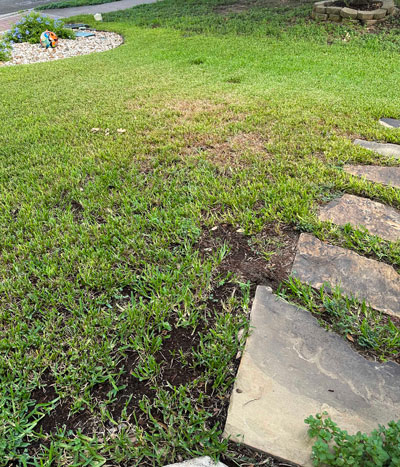
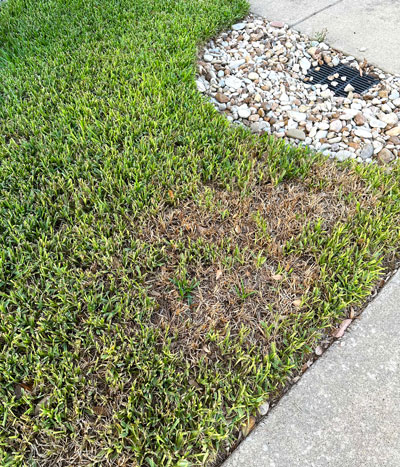
Answer: This is not fungal. If it’s not chinch bugs I’d be amazed. I suspect you may have missed them. They’re small and they’re right down on the ground, beneath the blades hanging out with the runners. You have to get on all fours and part the grass with your hands. They’re BB-sized, black with irregular white diamonds on their wings, and the smaller red nymphs will be there with them. You’ll find them at the edge of the dying grass, not in the brown grass. Look again mid-afternoon on a hot, sunny day. My fear is that your lawn now looks much worse in the six days since you sent me your question. Once you confirm them, use one of the insecticides labeled for chinch bugs as soon as possible.
QUESTION 6
CAN MY BURKII JUNIPER SURVIVE?
Question: We purchased several eastern redcedar Burkii junipers last fall. Obviously, I didn’t give this one enough water in the heat. I’m now soaking it and the browning appears to have stopped. Will it come back? Kimberly R., Sanger.
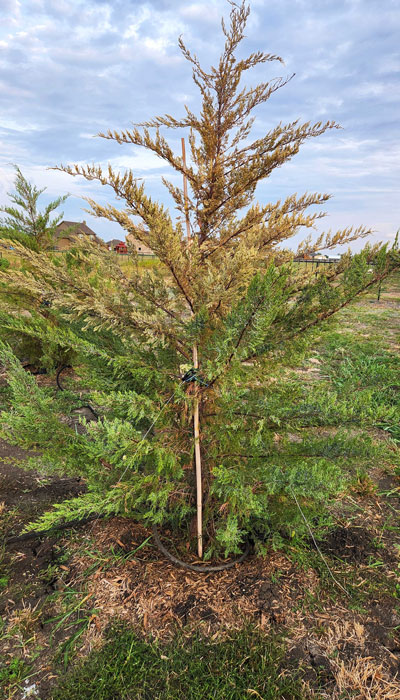
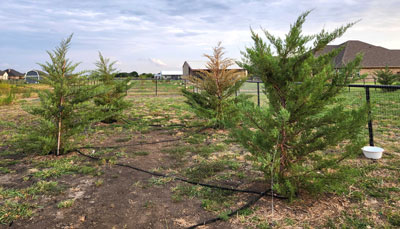
Answer: It will probably come back, but the top will have to be pruned off and new growth trained to fill in the void. I think I’m seeing similar browning on the other plant in the back row. Honestly, if these were my plants I’d take a hoe and pull a basin around each one of them so that I could soak them deeply and thoroughly every two days using a bubbler or breaker. See my story on watering in this issue.
